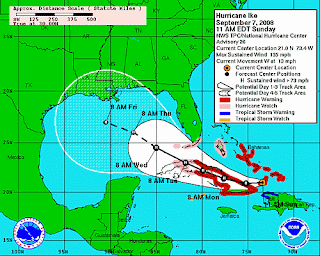

 11 pm Update:
11 pm Update: There is virtually no change in the intensity or track of Hurricane Ike at 11 pm. The minimum pressure has risen slightly to 956 mb. The current location of the center is about 340 miles southeast of
Galveston, Texas. On the forecast track, Ike will make landfall somewhere near Galveston in about 24 to 30 hours as a Category 2 storm. The main risk from Ike is for a very large storm surge near and to the right (north) of the center.
8 pm Update: It's sounding like a broken record, but Hurricane Ike continues to have maximum winds of 100 mph, and it's moving west northwest. The forward speed is just a little bit faster, though, at 12 mph. A slightly more northerly track is expected by late Friday. The dimensions of tropical storm and hurricane force winds also remain the same as before.
Images (top to bottom): Hurricane Ike satellite view from The Weather Channel, Ike track forecast from National Hurricane Center, Galveston Wave Cam at 6 pm local time 5 pm Update:Hurricane Ike continues to be a very large Category 2 storm with maximum winds of 100 mph. The storm is moving west northwest at 10 mph toward a landfall on the Texas coast Friday night. Model runs this afternoon have shifted the track of the storm more to the north, and the forecast has been adjusted accordingly. This brings the landfall closer to, but still south of, the Galveston/Houston area. Average forecast track errors at 36 hours are about 100 miles.
Hurricane force winds extend up to 115 miles, and tropical storm force winds extend up to 275 miles, from the center. Because of the large extent of strong winds, a much higher storm surge is likely than would otherwise be expected from a storm of this intensity. The National Hurricane Center has warned:
COASTAL STORM SURGE FLOODING OF UP TO 20 FT ABOVE NORMAL TIDE LEVELS...ALONG WITH LARGE AND DANGEROUS BATTERING WAVES...CAN BE EXPECTED NEAR AND TO THE EAST OF WHERE THE CENTER OF IKE MAKES LANDFALL...EXCEPT AT THE HEADS OF BAYS...WHERE SURGE FLOODING OF UP TO 25 FT COULD OCCUR. COASTAL STORM SURGE FLOODING OF 6 TO 8 FEET ABOVE NORMAL TIDE LEVELS...ALONG WITH LARGE AND DANGEROUS WAVES...CAN BE EXPECTED WITHIN THE TROPICAL STORM WARNING AREA ALONG THE NORTHERN GULF COAST. ABOVE NORMAL TIDES IN THE EASTERN GULF OF MEXICO SHOULD GRADUALLY SUBSIDE OVER THE NEXT DAY OR SO.
Complete hurricane local statements for affected Gulf Coast areas, including evacuation orders, are available
here.
3:30 Update:The National Weather Service has issued the following warning for Gulf-facing coastal areas from Matagorda to High Island, Texas:
LIFE THREATENING INUNDATION LIKELY!
ALL NEIGHBORHOODS...AND POSSIBLY ENTIRE COASTAL COMMUNITIES... WILL BE INUNDATED DURING HIGH TIDE. PERSONS NOT HEEDING EVACUATION ORDERS IN SINGLE FAMILY ONE OR TWO STORY HOMES WILL FACE CERTAIN DEATH. MANY RESIDENCES OF AVERAGE CONSTRUCTION
DIRECTLY ON THE COAST WILL BE DESTROYED. WIDESPREAD AND DEVASTATING PERSONAL PROPERTY DAMAGE IS LIKELY ELSEWHERE. VEHICLES LEFT BEHIND WILL LIKELY BE SWEPT AWAY. NUMEROUS ROADS WILL BE SWAMPED...SOME MAY BE WASHED AWAY BY THE WATER. ENTIRE FLOOD PRONE COASTAL COMMUNITIES WILL BE CUTOFF. WATER LEVELS MAY EXCEED 9 FEET FOR MORE THAN A MILE INLAND. COASTAL RESIDENTS IN MULTI-STORY FACILITIES RISK BEING CUTOFF. CONDITIONS WILL BE WORSENED BY BATTERING WAVES. SUCH WAVES WILL EXACERBATE PROPERTY DAMAGE...WITH MASSIVE DESTRUCTION OF HOMES...INCLUDING THOSE OF BLOCK CONSTRUCTION. DAMAGE FROM BEACH EROSION COULD TAKE YEARS TO REPAIR.
Complete hurricane local statements for affected Gulf Coast areas, including evacuation orders, are available
here.

 Original post:
Original post:Hurricane Ike's Intensity Holding Steady
As of 2 pm, Hurricane Ike is still a Category 2 storm with maximum winds of 100 mph. The storm has made a slight jog to the northwest, but it's still on a generally west northwest track at 10 mph toward a Texas landfall by late Friday. The storm's circulation is very large, with hurricane force winds extending up to 115 miles and tropical storm winds extending outward 275 miles.
See the
previous post for why Ike's IKE (integrated kinetic energy) matters. WeatherUnderground has
posted projections of worst-case storm surge scenarios for various locations along the Texas coast.



 After making landfall at 2:10 am at Galveston, Hurricane Ike is gradually weakening as it moves further inland over Texas. The storm made landfall as a large Category 2 storm, and its effects are being felt far inland. At 10 am CDT, maximum winds were 80 mph, with higher gusts, and the storm is likely to remain a hurricane into Saturday afternoon.
After making landfall at 2:10 am at Galveston, Hurricane Ike is gradually weakening as it moves further inland over Texas. The storm made landfall as a large Category 2 storm, and its effects are being felt far inland. At 10 am CDT, maximum winds were 80 mph, with higher gusts, and the storm is likely to remain a hurricane into Saturday afternoon. 














































